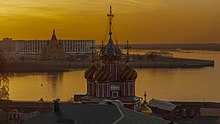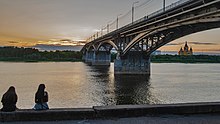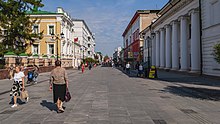Nizhny Novgorod
![]()
Nizhny-Novgorod is a redirect to this article. For other meanings, see Novgorod (disambiguation).
Nizhny Novgorod (Russian Нижний Новгород ( ![]() ); 1932 to 1990 Gorki, Russian Горький) is Russia's fifth-largest city, with a population of 1.26 million (as of 2018) and more than two million in the region. It is located about 400 km east of Moscow at the confluence of the Oka and Volga rivers and is the capital of Nizhny Novgorod Oblast and the Volga Federal District.
); 1932 to 1990 Gorki, Russian Горький) is Russia's fifth-largest city, with a population of 1.26 million (as of 2018) and more than two million in the region. It is located about 400 km east of Moscow at the confluence of the Oka and Volga rivers and is the capital of Nizhny Novgorod Oblast and the Volga Federal District.
Significant in Russian history, the city developed into a hub of Russian trade around 1850 and a major industrial metropolis during the Soviet era. Nizhny Novgorod is now an important political, economic, scientific and cultural centre of Russia. It is the largest transportation hub and government center of the Volga Federal District and one of the main destinations for river tourism in Russia. The city center is home to universities, churches, museums and theaters. The Kremlin is the most important structure in the Nizhny Novgorod Old Town. On its territory are concentrated city authorities.

Strelka (confluence of the Oka and the Volga)
History
Medieval princely seat
The city was founded in 1221 by Yuri II. Vsevolodovich, the Grand Prince of Vladimir-Suzdal, at the confluence of the two main rivers of his dominion, the Volga and the Oka. The literal translation of Nizhny Novgorod is "Lower New Town." It is possible that it was given this name to distinguish it from the older Novgorod. Like Moscow and Tver, Nizhny Novgorod belonged to those newly founded cities which, due to their insignificance at that time, escaped devastation by the Mongols, but then developed into important political centres during the time of the "Tartar Yoke" (rule of the Golden Horde from the 13th-15th centuries). The importance of Nizhny Novgorod increased further after it was declared the capital of the principality of the same name in 1341, which separated from Vladimir-Suzdal. Grand Prince Dmitri Konstantinovich (1328-1383) was eager to make the capital of his empire an equal rival to Moscow. He began to build the Kremlin, the stone fortress, as a protection from the Tatars. He also, according to historiography, made a point of building several churches. In 1377, the monk Lavrenti commissioned the oldest surviving copy of the famous Nestor Chronicle.
In 1378 the city was destroyed by the troops of Mamai, the Emir of the Golden Horde.
Most powerful fortress of the Moscow Empire
After the city became part of the Grand Duchy of Moscow in 1392, the princes of Nizhny Novgorod called themselves "Shuiskie" and moved to Moscow, where they held important positions at court and briefly ascended the throne with Vasily IV. Nizhny Novgorod was regarded by the Muscovites primarily as an important fortress in their wars against the Kazan Tatars. The massive red brick Kremlin, one of the most powerful and oldest surviving Russian fortresses, was built under the guidance of "Peter the Italian" between 1508 and 1511. When the Tartars besieged the fortress in 1520 and 1536, it proved strong enough and withstood the attacks. After the conquest of Kazan in 1552 by the Grand Duke of Moscow, the economic importance of the city grew, as Moscow now controlled the entire Volga River. In 1612, a popular army, raised by the Nizhny-Novgorod merchant Kuzma Minin and led by Prince Dmitri Posharsky, drove the Polish troops out of Moscow, ending the so-called "Time of Troubles". Minin's bones are buried in the Nizhny Novgorod Kremlin.
In the course of the 17th century, the city experienced economic prosperity and was chosen by the Stroganovs, one of the richest merchant families in Russia, as a base and settlement for their ventures. The specific architectural and iconic style that emerged in Nizhny Novgorod around 1700 is known as the "Stroganov School". In 1719 the city became the center of a governorate.
Major trading city
→ Main articles: All-Russian Industrial and Crafts Exhibition 1896 and Nizhny Novgorod Governorate
In 1817, the Makarev Fair, one of the busiest trade markets in the world at the time, was moved to Nizhny Novgorod, attracting millions of visitors to the city year after year since then. By the middle of the 19th century, it had established itself as the trading city of the Russian Empire. Other economic sectors began to develop, and by the beginning of the 20th century the city was also one of the country's most important industrial centers. The bleak life of the proletariat in this city is realistically described in the novels of Maxim Gorky, who was born in Nizhny Novgorod. A famous saying reflecting Nizhny Novgorod's importance as a commercial city is: Moscow is the heart of Russia, Petersburg the head and Nizhny Novgorod its pocket.
Soviet city
The city was renamed Gorky (Горький) in 1932, after Maxim Gorky was officially recognized as a proletarian writer. It only regained its old name after the political changes in 1990.
In the 1930s, Gorky was given the status of a "closed city", which foreigners were not allowed to visit. The reason for this were the factories located here, which also produced armaments. In 1932, an automobile factory and an aircraft factory were opened. Among other things, nuclear submarines (of the Charlie class), fighter planes (such as the MiG-29 or the MiG-31) and tanks were produced in Gorki. It was not until 1991 that the city was reopened to visitors.
Also in the 1930s, Gorky overtook Saratov and Rostov-on-Don, cities that were still larger by population in the 1926 census, to become the third-largest city in the RSFSR and remained so until the late 1980s, when it was surpassed by Novosibirsk (and also by Ekaterinburg in 2005).
→ Main article: Air raids on Gorky
During the Second World War, the city rose to become the largest armaments location in the country. In 1941, anti-tank barriers were erected on the outskirts of the city and the production of armaments was expanded. Ammunition and the famous Katyusha rockets were now also produced here. By 1945, the German Luftwaffe flew 47 raids on the city to destroy the armaments factories. POW camp 112 was established in the Ssormowo district in 1945, all of whose inmates were taken prisoner in Bohemia after the surrender on May 8, 1945.
In the 1960s to 1980s, the city, like all major Soviet cities, was significantly expanded by the construction of new residential areas in prefabricated housing. In 1985 the Gorky metro was opened.
From 1980 to 1986, the city was the place of exile of nuclear physicist Andrei Sakharov. Sakharov had fallen out of favor with the communist regime after speaking out against the entry of Soviet troops into Afghanistan. He was expelled from Moscow and lived in Gorky under constant surveillance by the KGB in an apartment that can now be visited as the Sakharov Museum. In 1986, he received permission from Mikhail Gorbachev to return to Moscow.
Nizhny Novgorod in the Russian Federation
As early as the time of perestroika and into the 1990s, the city was considered a pioneer of market-economy reforms. While other regions of Russia still clung to the old system, the city was particularly progressive.
In 2000, as part of the restructuring of Russia's administrative structure under President Putin, Nizhny Novgorod became the capital of the Volga Federal District, with former Prime Minister Sergei Kiriyenko installed as its head. On 9 February 2012, the cable car between Nizhny Novgorod and Bor on the opposite bank of the Volga River was opened. On 24 June 2013, the suburban railway started.
On September 22, 2015, Vladimir Putin signed the decree "On the occasion of the 800th anniversary of the founding of the city of Nizhny Novgorod" with the recommendation to the state authorities of the member groups of the Russian Federation and local governments to participate in the preparation and implementation of the celebration of the 800th anniversary of the founding of the city of Nizhny Novgorod.

Kanawinski Bridge over the Oka River

Pedestrian zone in Bolshaya Pokrovskaya Street
Population
Overview
The ethnic composition of the city is largely homogeneous. About 95 percent of the city's residents count themselves as Russians. The average age of the population in 2011 was 39.9 years. 64 percent of the population was of working age. In 2009, there were 358,000 people of retirement age living in the city, 30 of whom were over 100 years old. In 2012, there were about 3700 families with many children. Those who raised three children or more were considered to have many children.
Population
| Number of persons | ||||||||||
| Year | 1897 | 1926 | 1939 | 1959 | 1970 | 1979 | 1989 | 2002 | 2010 | |
| Inhabitants | 90.053 | 182.000 | 643.689 | 941.962 | 1.170.133 | 1.344.474 | 1.438.133 | 1.311.252 | 1.250.619 | |
| 1926 rounded; plus Sormowo, incorporated 1928, 40,090 inhabitants | ||||||||||
Questions and Answers
Q: What is Nizhny Novgorod?
A: Nizhny Novgorod is the fourth largest city in Russia and the economic and cultural center of the Volga-Vyatka economic region.
Q: What is the population of Nizhny Novgorod?
A: In 2002, the population of Nizhny Novgorod was 1,311,252 and in 1989 it was 1,438,133.
Q: What are the first three largest cities in Russia?
A: The first three largest cities in Russia are Moscow, St. Petersburg, and Novosibirsk.
Q: What was Nizhny Novgorod called from 1932 to 1990?
A: From 1932 to 1990, Nizhny Novgorod was known as Gorky in honor of the writer Maxim Gorky.
Q: What is the administrative center of Nizhny Novgorod Oblast and Volga Federal District?
A: Nizhny Novgorod is the administrative center of Nizhny Novgorod Oblast and Volga Federal District.
Q: Is there another town with Novgorod in its name?
A: Yes, there is another town called Velikiy Novgorod with Novgorod in its name.
Q: What is the abbreviation for Nizhny Novgorod?
A: Nizhny Novgorod is often shortened to Nizhny.
Search within the encyclopedia